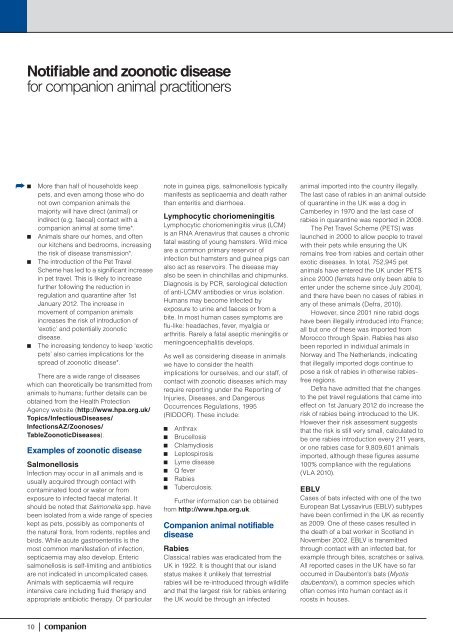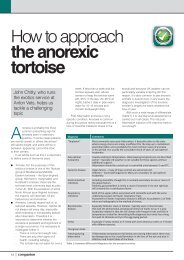Companion May 2012 - BSAVA
Companion May 2012 - BSAVA
Companion May 2012 - BSAVA
You also want an ePaper? Increase the reach of your titles
YUMPU automatically turns print PDFs into web optimized ePapers that Google loves.
Notifiable and zoonotic disease<br />
for companion animal practitioners<br />
■■ More than half of households keep<br />
pets, and even among those who do<br />
not own companion animals the<br />
majority will have direct (animal) or<br />
indirect (e.g. faecal) contact with a<br />
companion animal at some time*.<br />
■■ Animals share our homes, and often<br />
our kitchens and bedrooms, increasing<br />
the risk of disease transmission*.<br />
■■ The introduction of the Pet Travel<br />
Scheme has led to a significant increase<br />
in pet travel. This is likely to increase<br />
further following the reduction in<br />
regulation and quarantine after 1st<br />
January <strong>2012</strong>. The increase in<br />
movement of companion animals<br />
increases the risk of introduction of<br />
‘exotic’ and potentially zoonotic<br />
disease.<br />
■■ The increasing tendency to keep ‘exotic<br />
pets’ also carries implications for the<br />
spread of zoonotic disease*.<br />
There are a wide range of diseases<br />
which can theoretically be transmitted from<br />
animals to humans; further details can be<br />
obtained from the Health Protection<br />
Agency website (http://www.hpa.org.uk/<br />
Topics/InfectiousDiseases/<br />
InfectionsAZ/Zoonoses/<br />
TableZoonoticDiseases).<br />
Examples of zoonotic disease<br />
Salmonellosis<br />
Infection may occur in all animals and is<br />
usually acquired through contact with<br />
contaminated food or water or from<br />
exposure to infected faecal material. It<br />
should be noted that Salmonella spp. have<br />
been isolated from a wide range of species<br />
kept as pets, possibly as components of<br />
the natural flora, from rodents, reptiles and<br />
birds. While acute gastroenteritis is the<br />
most common manifestation of infection,<br />
septicaemia may also develop. Enteric<br />
salmonellosis is self-limiting and antibiotics<br />
are not indicated in uncomplicated cases.<br />
Animals with septicaemia will require<br />
intensive care including fluid therapy and<br />
appropriate antibiotic therapy. Of particular<br />
10 | companion<br />
note in guinea pigs, salmonellosis typically<br />
manifests as septicaemia and death rather<br />
than enteritis and diarrhoea.<br />
Lymphocytic choriomeningitis<br />
Lymphocytic choriomeningitis virus (LCM)<br />
is an RNA Arenavirus that causes a chronic<br />
fatal wasting of young hamsters. Wild mice<br />
are a common primary reservoir of<br />
infection but hamsters and guinea pigs can<br />
also act as reservoirs. The disease may<br />
also be seen in chinchillas and chipmunks.<br />
Diagnosis is by PCR, serological detection<br />
of anti-LCMV antibodies or virus isolation.<br />
Humans may become infected by<br />
exposure to urine and faeces or from a<br />
bite. In most human cases symptoms are<br />
flu-like: headaches, fever, myalgia or<br />
arthritis. Rarely a fatal aseptic meningitis or<br />
meningoencephalitis develops.<br />
As well as considering disease in animals<br />
we have to consider the health<br />
implications for ourselves, and our staff, of<br />
contact with zoonotic diseases which may<br />
require reporting under the Reporting of<br />
Injuries, Diseases, and Dangerous<br />
Occurrences Regulations, 1995<br />
(RIDDOR). These include:<br />
■■ Anthrax<br />
■■ Brucellosis<br />
■■ Chlamydiosis<br />
■■ Leptospirosis<br />
■■ Lyme disease<br />
■■ Q fever<br />
■■ Rabies<br />
■■ Tuberculosis.<br />
Further information can be obtained<br />
from http://www.hpa.org.uk.<br />
<strong>Companion</strong> animal notifiable<br />
disease<br />
Rabies<br />
Classical rabies was eradicated from the<br />
UK in 1922. It is thought that our island<br />
status makes it unlikely that terrestrial<br />
rabies will be re-introduced through wildlife<br />
and that the largest risk for rabies entering<br />
the UK would be through an infected<br />
animal imported into the country illegally.<br />
The last case of rabies in an animal outside<br />
of quarantine in the UK was a dog in<br />
Camberley in 1970 and the last case of<br />
rabies in quarantine was reported in 2008.<br />
The Pet Travel Scheme (PETS) was<br />
launched in 2000 to allow people to travel<br />
with their pets while ensuring the UK<br />
remains free from rabies and certain other<br />
exotic diseases. In total, 752,945 pet<br />
animals have entered the UK under PETS<br />
since 2000 (ferrets have only been able to<br />
enter under the scheme since July 2004),<br />
and there have been no cases of rabies in<br />
any of these animals (Defra, 2010).<br />
However, since 2001 nine rabid dogs<br />
have been illegally introduced into France;<br />
all but one of these was imported from<br />
Morocco through Spain. Rabies has also<br />
been reported in individual animals in<br />
Norway and The Netherlands, indicating<br />
that illegally imported dogs continue to<br />
pose a risk of rabies in otherwise rabiesfree<br />
regions.<br />
Defra have admitted that the changes<br />
to the pet travel regulations that came into<br />
effect on 1st January <strong>2012</strong> do increase the<br />
risk of rabies being introduced to the UK.<br />
However their risk assessment suggests<br />
that the risk is still very small, calculated to<br />
be one rabies introduction every 211 years,<br />
or one rabies case for 9,809,601 animals<br />
imported, although these figures assume<br />
100% compliance with the regulations<br />
(VLA 2010).<br />
EBLV<br />
Cases of bats infected with one of the two<br />
European Bat Lyssavirus (EBLV) subtypes<br />
have been confirmed in the UK as recently<br />
as 2009. One of these cases resulted in<br />
the death of a bat worker in Scotland in<br />
November 2002. EBLV is transmitted<br />
through contact with an infected bat, for<br />
example through bites, scratches or saliva.<br />
All reported cases in the UK have so far<br />
occurred in Daubenton’s bats (Myotis<br />
daubentonii), a common species which<br />
often comes into human contact as it<br />
roosts in houses.



